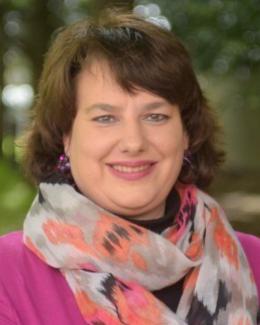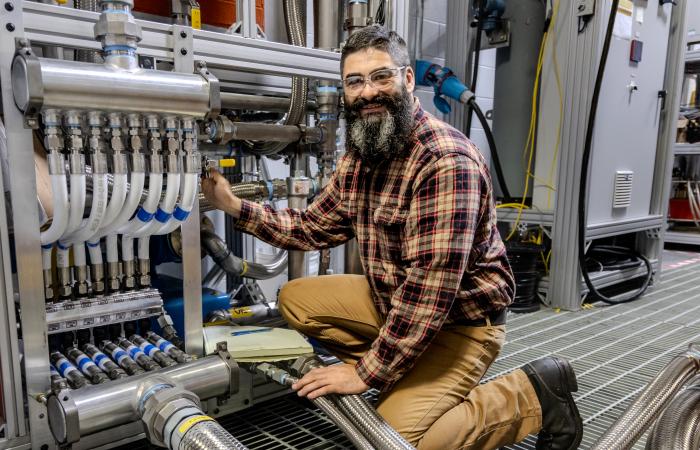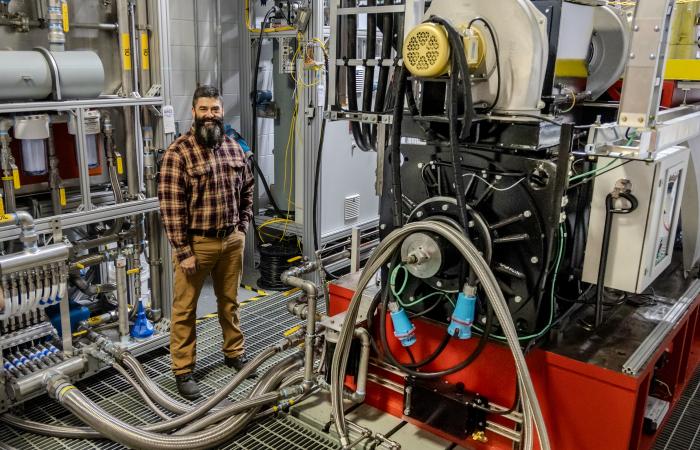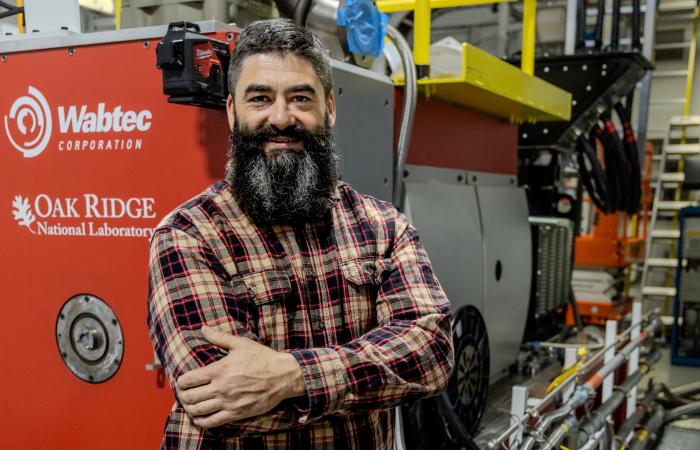Within the Department of Energy’s National Transportation Research Center at Oak Ridge National Laboratory’s Hardin Valley Campus, scientists investigate engines designed to help the U.S. pivot to a clean mobility future. From a marine engine powered by biofuels to a train engine that runs on hydrogen, these research platforms help industry develop new technologies for commercial deployment.
As a technical staff member in the Applied Catalysis and Emissions Research group at ORNL, Eric Nafziger is the unassuming engine expert tasked with making sure the complex, diverse systems operate seamlessly.
“I somehow find myself dropped into opportunities and grow from where I’m planted,” he said. “In my nearly 20 years of working in transportation research, I’ve never gone through a bigger transition than what I’ve experienced over the past few years. When we installed the ExxonMobil marine research engine, that was a big turning point.”
From roads and waterways to train tracks
In 2016, Nafziger found himself wading in unknown waters as he coordinated the installation of one of ORNL’s largest research engines. The laboratory partnered with ExxonMobil to investigate using low-sulfur fuels and lubricants in engines on cargo vessels for marine shipping. The team setup a custom 12 feet tall, 16,000-pound engine, called The Enterprise.
“I had never worked with these types of engines before; I was used to combustion engines for cars and trucks,” he said. “This was a monumental undertaking and one of the most challenging projects I’ve ever been involved in.”
His job included sorting out details among engineering contractors, riggers, welders and fabricators. The project involved coordination with two other partners – Mahle Powertrain and Seacoast – who custom-built the engine based on the research requirements and laboratory cell specifications.
"I was in charge of the mechanical aspects, designing the support systems and procuring parts for fabrication, and then working with the rigging team to safely install these heavy parts,” Nafziger said. “When you’re working with an engine of this scale, you can’t just go to an auto parts store for supplies. Almost everything is a custom solution.”
Finding those not-so-easy to come by answers is largely what has built Nafziger’s career at ORNL.
“This is the part of my job that I enjoy, when you have an engineering design that has to be met and then scratching your head and thinking how you can make that work and not only make it work, but then package it to fit within the space constraints,” he said. “We’re talking about some places where the clearances are down to a fourth of an inch. Packaging had to be compact and precise.”
Nafziger’s focus is integrating coordinated designs into systems in a safe way so that research goals are met. His technical expertise led to The Enterprise’s on-time installation in October 2016, which was celebrated with a public ribbon-cutting and dedication.
“It took about 19 months just to get the go-ahead on the engine and the work agreement in place and from there, a year or so of planning to reach that milestone,” he said. “I’m proud to see the research accomplishments that have been made since then, too.”
Research performed on The Enterprise has already helped inform the development of next-generation lubricants. Ongoing research is supporting the marine industry’s shift to renewable fuels such as biodiesel, renewable diesel and bio-oils. In addition, the project has opened the door for more engine industry collaborations focused on methanol and ammonia, with Nafziger once again involved in the coordination of bringing new capabilities online at the National Transportation Research Center, or NTRC.
Nafziger was recently presented with another complex installation to navigate – this time on the railway. He’s been the lead technical support for a train engine that runs on hydrogen, the centerpiece of a research collaboration with industry partner Wabtec.
“Little did I know, right around the corner was going to be the next big thing, which is perhaps even a little larger setup with the train engine,” he said. “The engine itself is very large, a 40,000-pound single cylinder engine and dynamometer testbed. But the real engineering challenge around that is all the support skids and the infrastructure to very tightly control all of this in one lab cell.”
Nafziger said a project of that scope begins with something basic.
“I unpack a lot of boxes,” he said. “I’m sorting, arranging, organizing; putting the pieces together. This train engine represents a big transition in the fuel usage, and so rather than traditional gasoline and diesel, this will be a first of its kind, running on hydrogen. I support getting the cell space ready for that.”
With Nafziger’s assistance, the train engine installation happened in November 2022. Since then, he’s worked to further build out the infrastructure around the engine, which will first run on diesel, then introduce hydrogen, switching ultimately to a high replacement percentage of hydrogen within the next three years.
Career growth points back to fundamentals
While Nafziger has been caught up in a tide of change in transportation research over the past decade, he’s known to be a stable force at the NTRC. He has called upon the advice of mentors from years ago, and some he still works with today, to help guide his decisions.
“I started working at the NTRC in the facility’s beginning years, when I was a mechanical engineering student working on my bachelor’s at the University of Tennessee, Knoxville,” he said. “This was back in 1999 when I was in the maintenance and reliability engineering program, which allowed me to get professional development and education.”
Nafziger, who is also a first-generation college graduate, said the program provided instruction on combustion engine operation, including vibration monitoring, electrical signature analysis, signal processing, tribology, failure modes and reliability-centered maintenance.
“As a student, I was working alongside experts in engine design and operation, researchers who have made the NTRC what it is today, and I’ve worked in some of the facility’s earliest test cells and on small single cylinder engines,” he said. “People like John Storey, Ron Graves, Scott Sluder, Stuart Daw, Mike Kass and Robert Wagner, who at that time was a postdoctoral student himself, and now leads transportation research at ORNL.
“These experts gave me that hands-on guidance. They helped me build my confidence, instilled in me those values that I’ve carried along to be able to perform tasks that I could have never dreamed of as a student,” he added.
A future built on confidence
In 2004, Nafziger was hired full-time at the lab supporting fuels and emissions research work. He moved up to his current technical professional role in 2019. This most recent position led to Nafziger achieving what he said is one of his proudest accomplishments – the discovery of a novel steerable hub-mounted dynamometer system that could support research in a new laboratory space dedicated to connected and automated vehicles.
“In order for this laboratory to perform advanced research on modern vehicles, we had to have a unique type of dynamometer for measuring performance and simulating physical conditions,” he said. “I found this system with a company based in Japan but to bring that system here, I had to get a lot of internal support, manage the relationship with the company and support the infrastructure changes here to make it a reality.”
Eventually, all worked out and the system was installed in early 2020 with a fully functional laboratory space commemorated later that year.
“I don’t know if I would have been able to move forward with such a huge undertaking without the confidence of my mentors,” he said. “We even had the added challenge of completing this task during the pandemic, too. I remember the partners from Japan and a technician from Sweden were some of the last external onsite visitors in February 2020 before everything closed down. But it just all fell into place.”
Looking back, Nafziger said things having a way of working out as they eventually should is a theme that he’s carried through much of his life. He learned that firsthand from his father.
“I am one of four kids. We moved a lot when I was a child because my dad did those hard waste remediation and removal jobs, and he was a welder, too,” he said. “He could fix anything and figure it out; he knew how to make things work. He moved us to Knoxville when I was in third grade, and I’ve remained here to raise my own family.”
Now a father of eight, five girls and three boys, Nafziger plans to instill that same gift of confidence he’s been bestowed throughout his career. He said one of his daughters is already showing an interest in mechanics and engineering.
“Our oldest girl, at almost 13 years of age, is very confident with herself; she is a natural leader,” he said. “The other day, she told my wife that she’s about done with school. She's learned pretty much everything there is, except she needs a little more practice on welding, and sometimes she gets her colors mixed up on wiring up electrical things.”
UT-Battelle manages ORNL for DOE’s Office of Science, the single largest supporter of basic research in the physical sciences in the United States. DOE’s Office of Science is working to address some of the most pressing challenges of our time. For more information, visit energy.gov/science.





